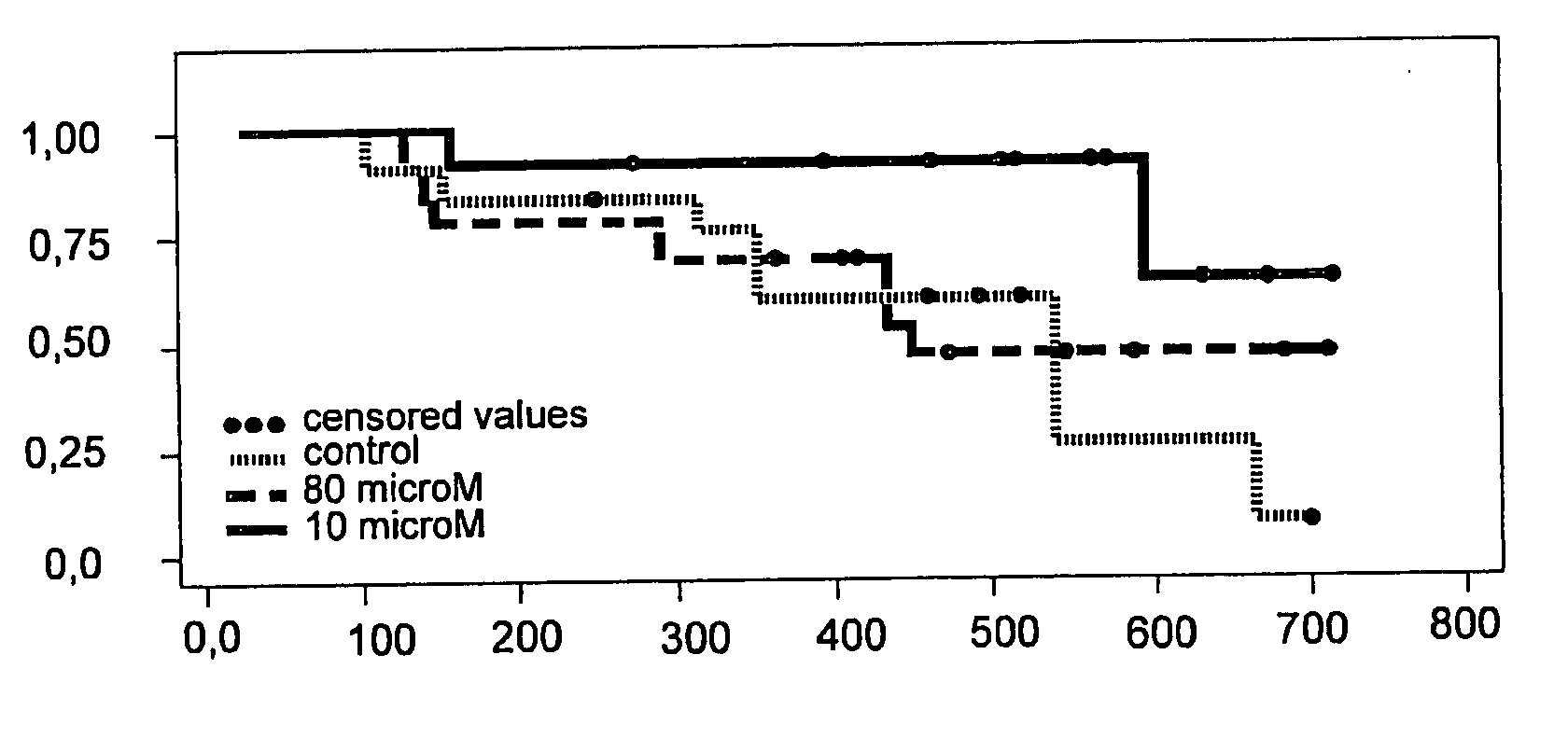Use Of Low Doses Of Oligonucleotides Antisense To TGF-Beta, VEGF, Interleukin-10, C-Jun, C-Fos Or Prostaglandin E2 Genes In The Treatment Of Tumors
a technology of oligonucleotides and tumors, applied in the field of pharmaceutical compositions, can solve the problems of limited clinical success of these substances, increased severe side effects and toxicities, and limited cellular uptake of substances
- Summary
- Abstract
- Description
- Claims
- Application Information
AI Technical Summary
Benefits of technology
Problems solved by technology
Method used
Image
Examples
example 1
Local Toxicity Studies after Intrathecal Bolus Injection in Rabbits
[0115]The local safety and tolerability of a pharmaceutical preparation comprising the antisense oligonucleotide against mRNA of TGF-beta2 identified by SEQ ID NO 5 was demonstrated in local toxicity studies applying said oligonucleotide intrathecally into rabbits as a bolus. Two studies were carried out each with eight rabbits (2 / gender / treatment group) administering 0.1 ml of a 14 microM or a 500 microM solution of said oligonucleotide in normal saline, respectively, by single intrathecal bolus injection into the subarachnoidal space of the lumbar region. The control groups received 0.9% NaCl solution in the same manner. Local reactions were inspected macroscopically 2, 6, and 30 hours after administration. Six and 30 hours after administration 1 animal / gender / group was sacrificed. Brain tissue samples (thickness approx. 5 microm) were examined histologically.
[0116]In none of the rabbits any clinical signs of toxic...
example 2
Local Toxicity Study after Intrathecal Bolus Injection in Cynomolgus Monkeys
[0120]The intrathecal bolus application described in example 1 was repeated in cynomolgus monkeys to investigate the safety and local tolerance of a solution of the antisense oligonucleotide with sequence ID No. 5 in a higher developed animal. Due to the excellent local tolerability of the 500 microM solution of the said antisense oligonucleotide against the mRNA of TGF-beta2 only this one concentration was investigated.
[0121]Two cynomolgus monkeys were treated with 0.1 mL of a 500 microM solution (0.9% sodium chloride) of an oligonucleotide hybridizing with the mRNA of TGF-beta2 identified in the sequence protocol by SEQ ID NO 5 by single intrathecal bolus injection into the subarachnoidal space of the lumbar region. Local reactions were inspected macroscopically 2, 6 and 30 hours after administration and then the animals were sacrificed. Brain tissue samples (thickness approx. 5 microm) were examined histo...
example 3
Local Toxicity Study after Continuous Intracerebral Infusion in Rabbits
[0124]Based on the excellent local tolerability of the 500 microM solution of the oligonucleotide identified by the SEQ ID NO. 5 after intrathecal bolus application in rabbits and monkeys described in example 1 and 2, a long-term continuous intracerebral infusion of a 500 microM solution of said oligonucleotide over seven days was investigated in rabbits with regards to local toxicity.
[0125]Eight rabbits (2 / gender / treatment group) were treated with a 500 microM solution (0.9 sodium chloride) of an antisense oligonucleotide against the mRNA of TGF-beta2 identified in the sequence listing by SEQ ID NO 5 by continuous infusion into the cerebral parenchyma of the brain or with 0.9% sodium chloride solution as control, respectively. The infusion was performed at a flow rate of 1 microL / h for a period of 7 days employing a subcutaneously implanted osmotic pump. Clinical signs and mortality were checked and recorded dai...
PUM
| Property | Measurement | Unit |
|---|---|---|
| Time | aaaaa | aaaaa |
| Time | aaaaa | aaaaa |
| Time | aaaaa | aaaaa |
Abstract
Description
Claims
Application Information
 Login to View More
Login to View More - R&D
- Intellectual Property
- Life Sciences
- Materials
- Tech Scout
- Unparalleled Data Quality
- Higher Quality Content
- 60% Fewer Hallucinations
Browse by: Latest US Patents, China's latest patents, Technical Efficacy Thesaurus, Application Domain, Technology Topic, Popular Technical Reports.
© 2025 PatSnap. All rights reserved.Legal|Privacy policy|Modern Slavery Act Transparency Statement|Sitemap|About US| Contact US: help@patsnap.com



